![]()
![]()
![]()
Use LEFT and RIGHT arrow keys to navigate between flashcards;
Use UP and DOWN arrow keys to flip the card;
H to show hint;
A reads text to speech;
50 Cards in this Set
- Front
- Back
- 3rd side (hint)
|
1. The antecubital region is _________ to the carpals. |
proximal |
|
|
|
2. The posterior neck is referred to as the: |
nuchal region. |
|
|
|
3. In anatomic position, which of the following regions can be viewed from the posterior view? |
Dorsum of the hand. |
|
|
|
4. A plane that divides the body into anterior & posterior prts is a: |
frontal (coronal) plane. |
|
|
|
5. The following events are part of a negative-feedback mechanism. Place the events in correct order. |
4. Baroreceptors detect a decrease in blood pressure. 2. The Medulla compares actual blood pressure to the blood pressure set point. 3. The heart recieves a signal to increase it's cardiac output and heart rate. 1. Blood pressure increases. |
|
|
|
6. Organs of the abdominopelvic cavity that lack mesentaries are referred to as: |
retroperitoneal organs. |
|
|
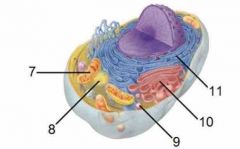
7. Which of the following is false regarding the mitochondria?
a. It is responsible for generating massive amounts of cellular energy in the form of ATP. b. It contains DNA. c. It lacks cristae. d. It contains membrane proteins that act as enzymes. |
b. It contains DNA. |
|
|

8. What component of the cytoskeleton is found within the labeled organelle?
a. Microtubule. b. Intermediate filaments. c. Microfilaments. d. None of the above. |
b. Intermediate filaments. |
|
|
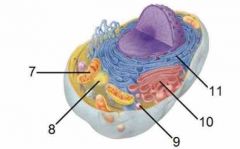
9. What process occurs when the lysosome extrudes its contents outside the cell?
a. Endocystosis. b. Exocystosis. c. Pinocystosis. d. Phagocystosis. |
b. Exocystosis. |
|
|
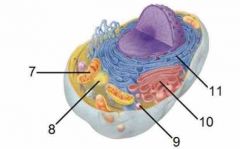
10. What is the function of the golgi apparatus?
a. To collect, modify, package, and distribute proteins & lipids manufactured by the endoplasmic reticulum. b. To breakdown fatty acids and amino acids, resulting in a hydrogen peroxide byproduct. c. To synthesize proteins. d. To synthesize lipids. |
a. To collect, modify, package, and distribute proteins and lipids manufactured by the endoplasmic reticulum. |
|
|
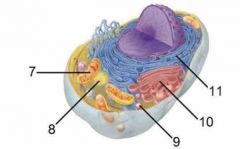
11. What is the function of the rough ER?
a. To collect, modify, package, and distribute proteins & lipids manufactured by the endoplasmic reticulum. b. To breakdown fatty acids and amino acids, resulting in a hydrogen peroxide byproduct. c. To synthesize proteins. d. To synthesize lipids. |
c. To synthesize proteins. |
|
|
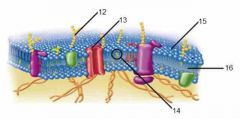
12. Identify the labeled item.
a. Symporter b. Uniporter c. Antiporter d. Glycolipid e. Glycoprotein |
d. Glycoprotein |
|
|
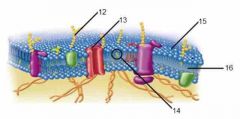
13. Identify the labeled item.
a. Peripheral membrane b. Attachment protein c. Marker molecule d. Membrane Channel (Transport Protein) |
d. Membrane Channel (Transport Protein) |
|
|
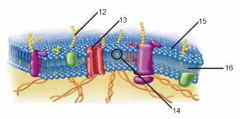
14. What is the function of thhe labeled item?
a. It is a component of the G-protein complex. b. It provides stability to the cell membrane. c. It binds to hormones allowing their passage through the membrane. d. It breaks down foreign materials within the cell. |
b. It provides stability to the cell membrane. |
|
|
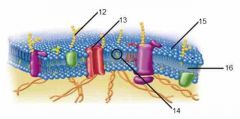
15. This region is considered to be:
a. Hydrophobic b. Hydrophilic c. Isotonic d. Hypertonic |
b. Hydrophilic |
|
|
|
16. This region is considered to be:
a. Hydrophobic b. Hydrophilic c. Isotonic d. Hypertonic |
a. Hydrophobic |
Lecture 3 - Cell Biology |
|
|
26. Identify the Popliteal region. (If choice is not available, choose "E".) |
C. |
Lecture 1 - The Human Organism |
|
|
27. Identify the Nuchal region. (If choice is not available, choose "E".) |
A. |
Lecture 1 - The Human Organism |
|
|
28. What body cavities are separated by the diaphragm? |
Thoracic and abdominopelvic cavities. |
Lecture 1 - The Human Organism |
|
|
29. A person lying face upwards is: |
Supine. |
Lecture 1 - The Human Organism |
|
|
30. What system is responsible for removing foreign substances from the blood & absorbing dietary fats from the digestive tract. |
Endocrine system. |
Lecture 1 - The Human Organism |
|
|
31. Weight is a(n) ___________ property. |
Extrinsic (dependent on environment). |
Lecture 2 - The Chemical Basis of Life |
|
|
32. Iron is represented by the symbol: |
Fe. |
Lecture 2 - The Chemical Basis of Life |
|
|
33. Which of the following statements is FALSE?
a. Protons and neutrons have roughly the same mass. b. Protons and electrons have roughly the same mass. c. The magnitude of charge between a proton and an electron is equal and opposite. d. In its elemental state, the number of protons and electrons are equal. |
b. Protons and electrons have roughly the same mass. |
Lecture 2 - The Chemical Basis of Life |
|
|
34. The atomic number of Potassium is 19, and the mass number is 39. How many neutrons are in an atom of Potassium? |
20. |
Lecture 2 - The Chemical Basis of Life |
|
|
35. An element with the same atomic number but different mass number is referred to as: |
An isotope. |
Lecture 2 - The Chemical Basis of Life |
|
|
17. Which of the choices above best demonstrates Prophase? |
B. |
Lecture 3 - Cell Biology |
|
|
36. What bond is formed when both atoms equally share their valence electrons? |
Nonpolar covalent bond. |
Lecture 2 - The Chemical Basis of Life |
|
|
37. Energy used to drive the cell's reactions are stored within which molecule? |
Adenosine Triphosphate (ATP). |
Lecture 3 - Cell Biology |
|
|
38. Enzymes speed up a chemical reaction by ____________ the activation energy. |
lowering |
Lecture 3 - Cell Biology |
|
|
39. Stomach acid contains a H+ concentration of 10^-1. What is the pH value of stomach acid? |
pH 1 |
Lecture 2 - The Chemical Basis of Life |
|
|
40. What bond holds the primary structure of all proteins or small peptides together? |
Peptide bond. |
Lecture 2 - The Chemical Basis of Life |
|
|
41. Which organelle functions to modify, package, and distribute proteins and lipids for secretion or internal use?
a. Lysosome b. Mitochondria c. Peroxisome d. Golgi apparatus |
d. Golgi apparatus |
Lecture 3 - Cell Biology |
|
|
42. Which organelle functions to synthesize lipids and detoxify chemicals within the cell?
a. Rough ER b. Smooth ER c. Cilia d. Microvilli |
b. Smooth ER |
Lecture 3 - Cell Biology |
|
|
43. Which of the following processes DOES NOT require ATP?
a. Endocytosis b. Exocystosis c. Active Transport d. Osmosis |
d. Osmosis |
Lecture 3 - Cell Biology |
|
|
44. If a cell is placed into a solution and water moves out of the cell by osmosis, causing the cell to shrink, the solution is a(n) _____________ solution. |
hypertonic |
Lecture 3 - Cell Biology |
|
|
45. Sperm cells possess which cellular extension?
a. Cilia b. Microvilli c. Flagella d. None of the above. |
c. Flagella |
Lecture 3 - Cell Biology |
|
|
18. Which of the choices above best demonstrates Metaphase? |
C. |
Lecture 3 - Cell Biology |
|
|
46. Which organelle is the major site for ATP production?
a. Rough ER b. Smooth ER c. Mitochondria d. Golgi apparatus |
c. Mitochondria |
Lecture 3 - Cell Biology |
|
|
47. The process of cell division of a somatic cell is referred to as: |
Mitosis. |
Lecture 3 - Cell Biology |
|
|
48. Acetylcholine binds to a receptor on a sodium channel allowing for sodium to diffuse through the channel. This is an example of a(n): |
Ligand-gated channel. |
Lecture 3 - Cell Biology |
|
|
____________ is the process of protein synthesis based on the codon sequence of a mRNA strand. |
Transcription |
Lecture 3 - Cell Biology |
|
|
50. Which of the following statement is FALSE regarding cholesterol?
a. Cholesterol makes the lipid bilayer stronger but less fluid at normal body temperature. b. Cholesterol increases membrane fluidity at low temperatures. c. Cholesterol is found only within the hydrophilic portions of the membrane. d. Cholesterol is composed of a four ring lipid. |
c. Cholesterol is found only within the hydrophilic portions of the membrane. |
Lecture 3 - Cell Biology |
|
|
19. Which of the choices above best demonstrates Anaphase? |
D. |
Lecture 3 - Cell Biology |
|
|
20. Which of the choices above best demonstrates Telophase? |
E. |
Lecture 3 - Cell Biology |
|
|
21. Which of the choices above best demonstrates Interphase? |
A. |
Lecture 3 - Cell Biology |
|
|
|
b. The transport proteins of the kidney tubules have been saturated with glucose. |
Lecture 1 - The Human Organism |
|
|
23. Identify the Cervical region. (If choice is not available, choose "E".) |
E. |
Lecture 1 - The Human Organism |
|
|
24. Identify the Olecranon. (If choice is not available, choose "E".) |
B. |
Lecture 1 - The Human Organism |
|
|
25. Identify the Sural region. (If choice is not available, choose "E".) |
E. |
Lecture 1 - The Human Organism |

